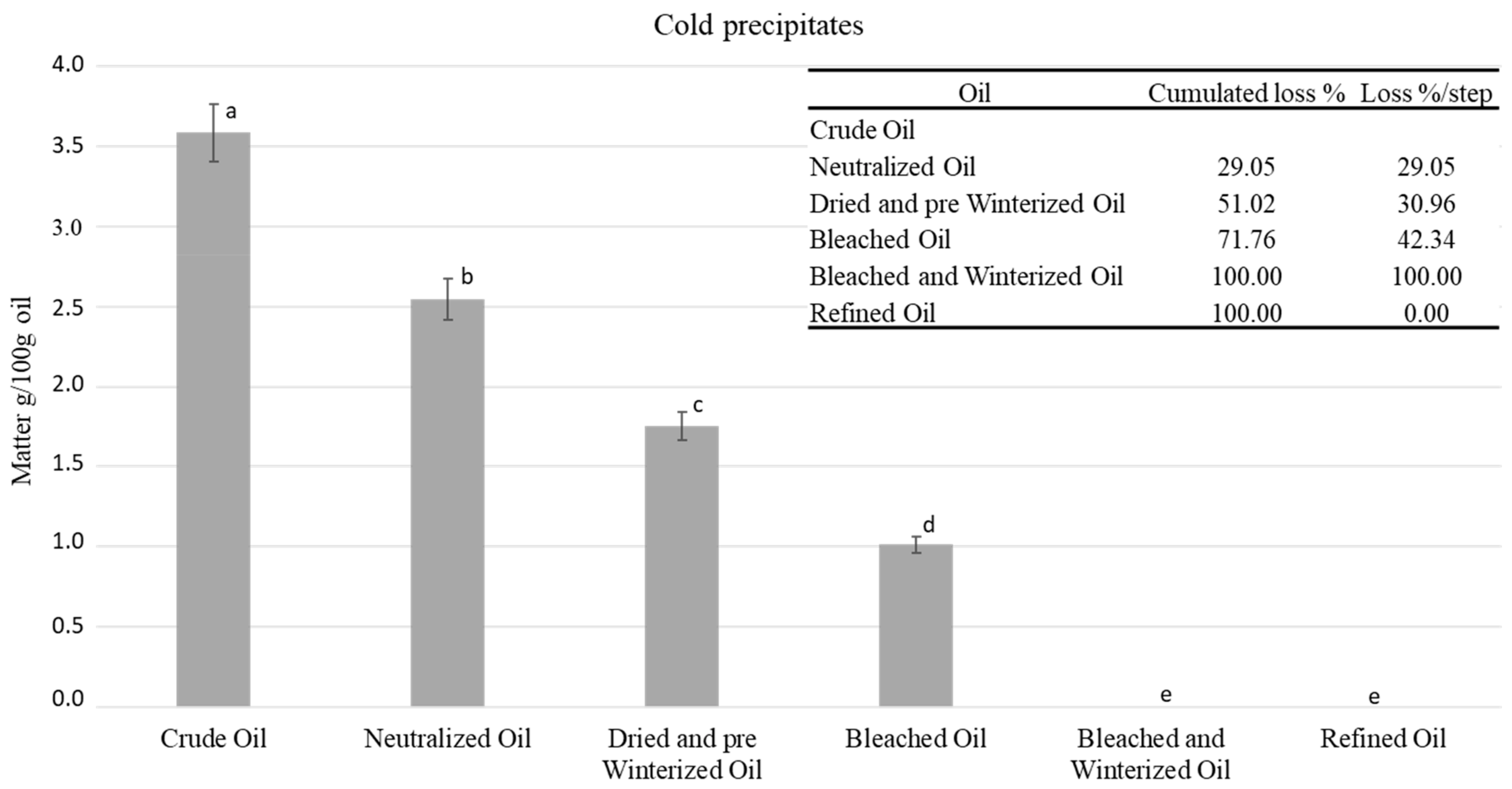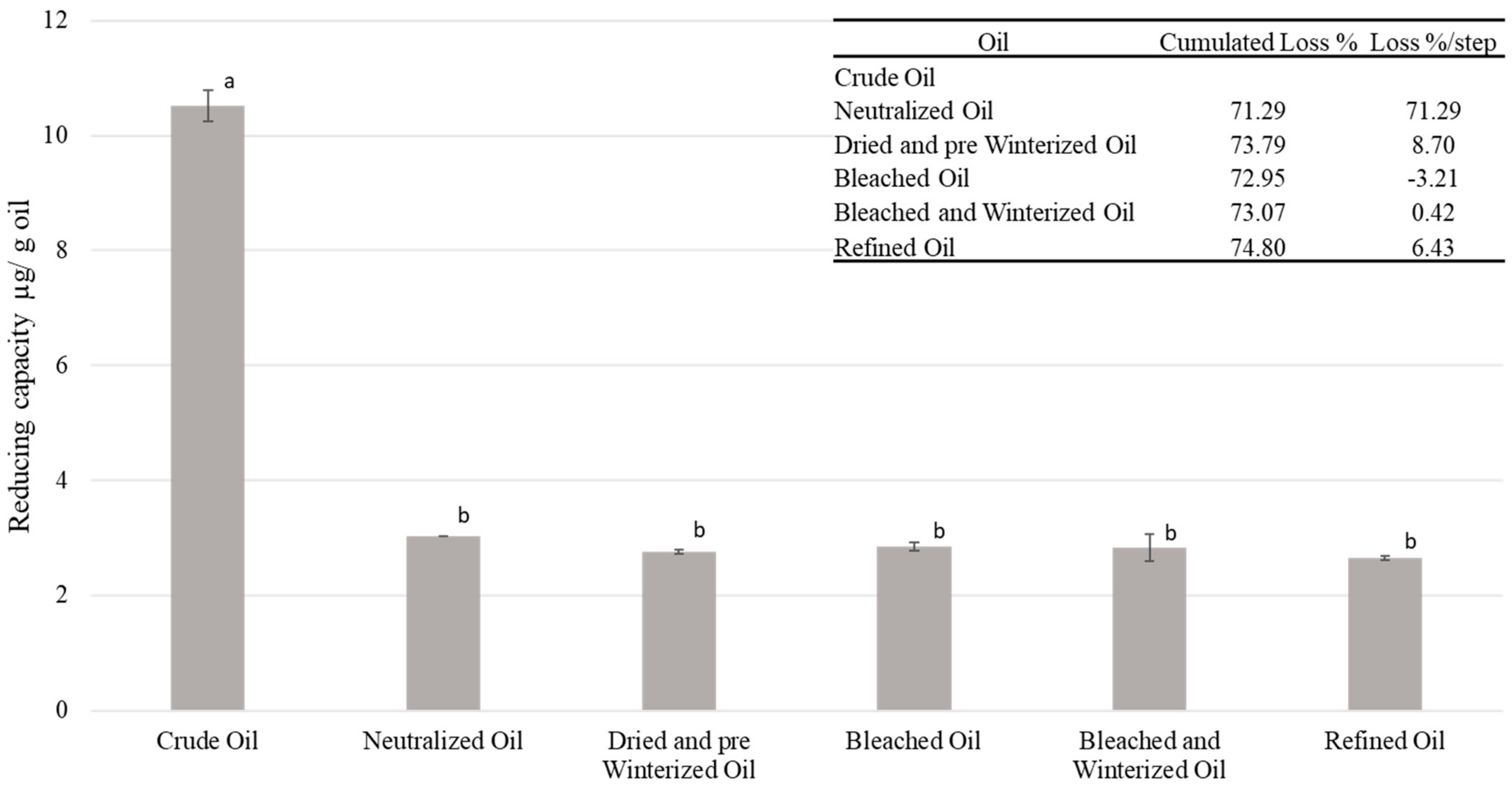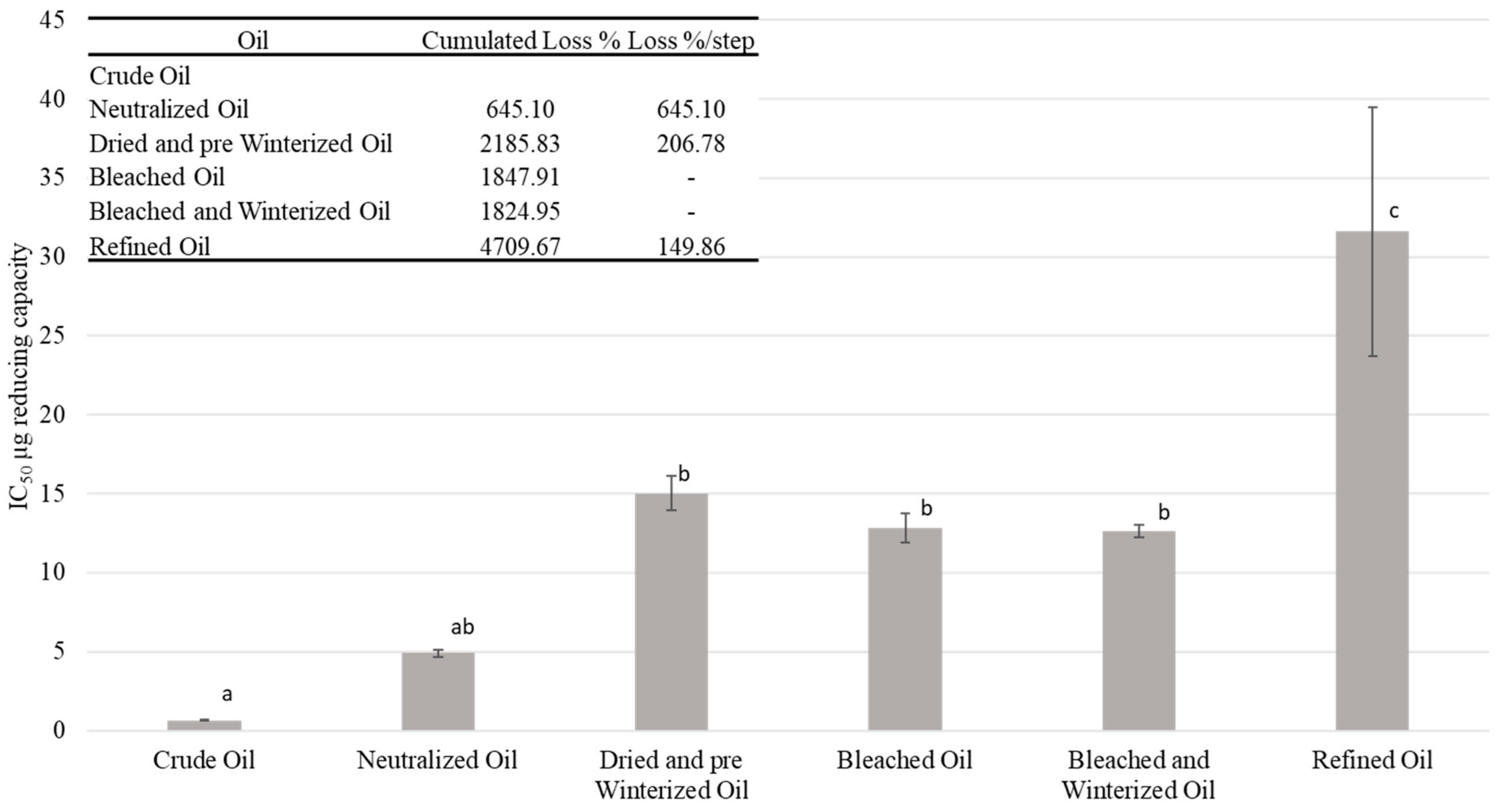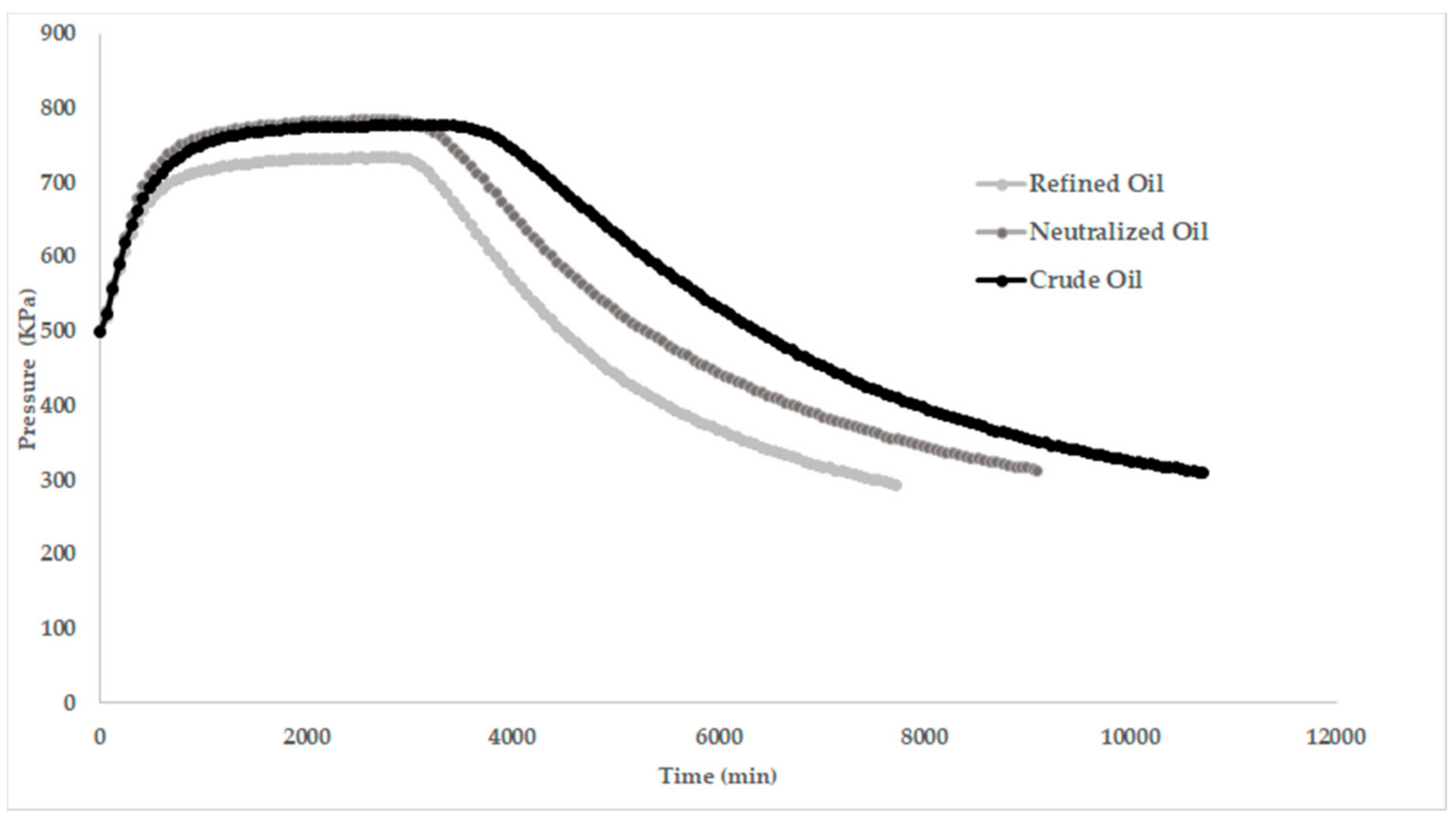Loss in the Intrinsic Quality and the Antioxidant Activity of Sunflower (Helianthus annuus L.) Oil during an Industrial Refining Process
Abstract
1. Introduction
2. Results
2.1. Cold Precipitates
2.2. Fatty Acids
2.3. Colorimetry
2.4. Tocopherol Analysis
2.5. Phytosterol Analysis
2.6. Squalene Analysis
2.7. Antioxidant Activity
2.7.1. Reducing-Capacity Analysis
2.7.2. DPPH
2.8. Oil Stability
3. Materials and Methods
3.1. Samples
3.2. Reagents
3.3. Physical Analyses
3.3.1. Cold Precipitates
3.3.2. Color Analysis
3.4. Chemical Analysis
3.4.1. Fatty Acids Composition
3.4.2. Tocopherols Analysis
3.4.3. Phytosterols and Squalene Analysis
3.4.4. Reducing Capacity
3.4.5. Pigments Analysis
3.4.6. Antioxidant Properties
DPPH Analysis
Accelerated Oxidative Stability
3.5. Statistical Analysis
4. Conclusions
Author Contributions
Funding
Institutional Review Board Statement
Informed Consent Statement
Data Availability Statement
Acknowledgments
Conflicts of Interest
References
- FAOSTAT. Available online: http://www.fao.org/faostat/en/#home (accessed on 11 January 2019).
- WHO/FAO. Fats and Oils in Human Nutrition. Report of a Joint FAO/WHO Expert Consultation; FAO: Rome, Italy, 1994. [Google Scholar]
- FAO. SECTION 2. Codex Standards for Fats and Oils from Vegetable Sources; FAO: Rome, Italy, 1999. [Google Scholar]
- Neto, A.R.; Rauen, A.; Mourad, A.; Henriques, E.; Alves, R.M.V. Environmental Effect on Sunflower Oil Quality. Crop Breed. Appl. Biotechnol. 2016, 16, 197–204. [Google Scholar] [CrossRef][Green Version]
- Ayerdi Gotor, A.; Berger, M.; Labalette, F.; Centis, S.; Daydé, J.; Calmon, A. Comparative Analysis of Fatty Acids, Tocopherols and Phytosterols Content in Sunflower Cultivars (Helianthus annuus) from a Three-Year Multi-Local Study. Phyton Int. J. Exp. Bot. 2015, 84, 14–25. [Google Scholar]
- Schulte, L.R.; Ballard, T.; Samarakoon, T.; Yao, L.; Vadlani, P.; Staggenborg, S.; Rezac, M. Increased Growing Temperature Reduces Content of Polyunsaturated Fatty Acids in Four Oilseed Crops. Ind. Crops Prod. 2013, 51, 212–219. [Google Scholar] [CrossRef]
- Matthäus, B. Use of Palm Oil for Frying in Comparison with Other High-Stability Oils. Eur. J. Lipid Sci. Technol. 2007, 109, 400–409. [Google Scholar] [CrossRef]
- Labalette, F.; Jouffret, P.; Merrien, A. Oleic Sunflower Production: Current Situation and Trends for the Future. In Proceedings of the XVIIIth International Congress, Mar del Plata, Argentina, 27 February–1 March 2012; Volume 1. [Google Scholar]
- Gondé, P.; Morin, O. Optimization of oil for industrial frying process: Mc Cain’s testimony. OCL—Oilseeds Fats 2012, 19, 96–100. [Google Scholar]
- Leao, J.D.; Bouillon, V.; Muntada, L.; Johnson, C.; Wilson, P.; Vergnes, O.; Dano, C.; Igartua, A.; Mendoza, G. New Formulations of Sunflower Based Bio-Lubricants with High Oleic Acid Content—VOSOLUB Project. OCL 2016, 23, D509. [Google Scholar] [CrossRef][Green Version]
- Ramos, M.J.; Fernández, C.M.; Casas, A.; Rodríguez, L.; Pérez, Á. Influence of Fatty Acid Composition of Raw Materials on Biodiesel Properties. Bioresour. Technol. 2009, 100, 261–268. [Google Scholar] [CrossRef]
- Cicerale, S.; Liem, D.G.; Keast, R. Consumer Perception, Attitudes, Liking and Preferences for Olive Oil. In Products from Olive Tree; InTech: Rijeka, Croatia, 2016; pp. 157–171. ISBN 978-953-51-2724-6. [Google Scholar]
- Packer, L.; Landvik, S. Vitamin E: Introduction to Biochemistry and Health Benefits. Ann. N. Y. Acad. Sci. 1989, 570, 1–6. [Google Scholar] [CrossRef]
- Ogbe, R.J.; Ochalefu, D.O.; Mafulul, S.G.; Olaniru, O.B. A Review of Dietary Phytosterols: Their Occurences, Metabolism and Health Benefits. Asian J. Plant Sci. Res. 2015, 5, 10–21. [Google Scholar]
- Kamal-Eldin, A. Effect of Fatty Acids and Tocopherols on the Oxidative Stability of Vegetable Oils. Eur. J. Lipid Sci. Technol. 2006, 108, 1051–1061. [Google Scholar] [CrossRef]
- Pehlivan, E.; Arslan, G.; Gode, F.; Altun, T.; Musa Özcan, M. Determination of Some Inorganic Metals in Edible Vegetable Oils by Inductively Coupled Plasma Atomic Emission Spectroscopy (ICP-AES). Grasas Aceites 2008, 59, 239–244. [Google Scholar] [CrossRef]
- Hamilton, R.J.; Kalu, C.; Prisk, E.; Padley, F.B.; Pierce, H. Chemistry of Free Radicals in Lipids. Antioxid. Food 1997, 60, 193–199. [Google Scholar] [CrossRef]
- Rodrigues, M.S.; Dos Passos, R.M.; de A Pontes, P.V.; Ferreira, M.C.; Meirelles, A.J.A.; Stevens, C.V.; Maximo, G.J.; Sampaio, K.A. Enzymatic Degumming of Rice Bran Oil Using Different Commercial Phospholipases and Their Cocktails. Life 2021, 11, 1197. [Google Scholar] [CrossRef]
- Abedi, E.; Amiri, M.J.; Sahari, M.A. Kinetic, Isotherm and Thermodynamic Investigations on Adsorption of Trace Elements and Pigments from Soybean Oil Using High Voltage Electric Field-Assisted Bleaching: A Comparative Study. Process. Biochem. 2020, 91, 208–222. [Google Scholar] [CrossRef]
- Maszewska, M.; Florowska, A.; Dłużewska, E.; Wroniak, M.; Marciniak-Lukasiak, K.; Żbikowska, A. Oxidative Stability of Selected Edible Oils. Molecules 2018, 23, 1746. [Google Scholar] [CrossRef] [PubMed]
- Baştürk, A.; Boran, G.; Javidipour, I. Effects of Ascorbyl Palmitate and Metal Ions on Oxidation of Sunflower Oil under Accelerated Oxidation Conditions. J. Anim. Plant Sci. 2017, 27, 2014–2024. [Google Scholar]
- Kalua, C.M.; Allen, M.S.; Bedgood, D.R.; Bishop, A.G.; Prenzler, P.D.; Robards, K. Olive Oil Volatile Compounds, Flavour Development and Quality: A Critical Review. Food Chem. 2007, 100, 273–286. [Google Scholar] [CrossRef]
- Baümler, E.R.; Carrín, M.E.; Carelli, A.A. Extraction of Sunflower Oil Using Ethanol as Solvent. J. Food Eng. 2016, 178, 190–197. [Google Scholar] [CrossRef]
- El-Hamidi, M.; Zaher, F. Comparison Between Some Common Clays as Adsorbents of Carotenoids, Chlorophyll and Phenolic Compounds from Vegetable Oils. Am. J. Food Technol. 2016, 11, 92–99. [Google Scholar] [CrossRef]
- Brevedan, M.I.V.; Carelli, A.A.; Crapiste, G.H. Changes in Composition and Quality of Sunflower Oils during Extraction and Degumming. Grasas Aceites 2000, 51, 417–423. [Google Scholar] [CrossRef]
- Jung, M.Y.; Yoon, S.H.; Min, D.B. Effects of Processing Steps on the Contents of Minor Compounds and Oxidation of Soybean Oil. J. Am. Oil Chem. Soc. 1989, 66, 118–120. [Google Scholar] [CrossRef]
- Ayerdi Gotor, A.; Rhazi, L. Effects of Refining Process on Sunflower Oil Minor Components: A Review. OCL 2016, 23, D207. [Google Scholar] [CrossRef]
- Zhang, Q.; Saleh, A.S.M.; Chen, J.; Shen, Q. Chemical Alterations Taken Place during Deep-Fat Frying Based on Certain Reaction Products: A Review. Chem. Phys. Lipids 2012, 165, 662–681. [Google Scholar] [CrossRef] [PubMed]
- Aluyor, E.; Ozigagu, C.; Oboh, I. Chromatographic Analysis of Vegetable Oils: A Review. Sci. Res. Essay 2009, 4, 191–197. [Google Scholar]
- Fei, T.; Wang, T. A Review of Recent Development of Sustainable Waxes Derived from Vegetable Oils. Innov. Food Sci. Foodomics Technol. 2017, 16, 7–14. [Google Scholar] [CrossRef]
- Shalini, T.; Martin, A. Identification, Isolation, and Heterologous Expression of Sunflower Wax Synthase for the Synthesis of Tailored Wax Esters. J. Food Biochem. 2020, 44, e13433. [Google Scholar] [CrossRef]
- Chalapud, M.C.; Baümler, E.R.; Carelli, A.A. Characterization of Waxes and Residual Oil Recovered from Sunflower Oil Winterization Waste. Eur. J. Lipid Sci. Technol. 2017, 119, 1500608. [Google Scholar] [CrossRef]
- Maru, A.; Pattamatta, U.; Patravale, V. Sunflower Wax as a New Natural Cosmetic Raw Material: Purification and Application in Lipsticks. Res. J. Pharm. Dos. Forms Techonol. 2009, 1, 45–48. [Google Scholar] [CrossRef]
- Maru, A.; Lahoti, S. Formulation and Evaluation of Moisturizing Cream Containing Sunglower Wax. Int. J. Pharm. Pharm. Sci. 2018, 10, 54. [Google Scholar] [CrossRef]
- Winkler-Moser, J.K.; Anderson, J.; Byars, J.A.; Singh, M.; Hwang, H.-S. Evaluation of Beeswax, Candelilla Wax, Rice Bran Wax, and Sunflower Wax as Alternative Stabilizers for Peanut Butter. J. Am. Oil Chem. Soc. 2019, 96, 1235–1248. [Google Scholar] [CrossRef]
- Soomro, K.R.; Sherazi, T.H.; Shaikh, S.A. Effects of Sunflower Wax Coating on Physicochemical Changes of Mangifera indica L. in Storage Life. Pak. J. Anal. Environ. Chem. 2013, 14, 42–46. [Google Scholar]
- Demirci, M.; Pehlivanoğlu, H. Potential Food Applications of Sunflower Wax. In Proceedings of the International Sunflower Conference, Edirne, Turkey, 3 June 2016. [Google Scholar]
- Mohdaly, A.; Seliem, K.; EL-Hassan, A.; Mahmoud, A. Effect of Refining Process on the Quality Characteristics of Soybean and Cotton Seed Oils. Int. J. Curr. Microbiol. Appl. Sci. 2017, 6, 207–222. [Google Scholar] [CrossRef]
- Pal, U.S.; Patra, R.K.; Sahoo, N.R.; Bakhara, C.K.; Panda, M.K. Effect of Refining on Quality and Composition of Sunflower Oil. J. Food Sci. Technol. 2015, 52, 4613–4618. [Google Scholar] [CrossRef] [PubMed]
- Buhalova, D.; Nikolova, K.; Antova, G.; Milkova-Tomova, I.; Aladjadjiyan, A.; Aleksieva, Y.; Petkova, Z. Comparative Characteristics of Sunflower Oil with Supplement of Traditional Bulgarian Herbs. Bulg. Chem. Commun. 2014, 46, 34–38. [Google Scholar]
- Vrbikova, L.; Schmidt, S.; Kreps, F.; Tmáková, L.; Certik, M.; Sekretár, S. Degradation of Selected Nutrients in Sunflower Oils during Long-Term Storage. Czech J. Food Sci. 2014, 32, 595–600. [Google Scholar] [CrossRef]
- Aguilar-Espinosa, M.; Alcalde, M.; Alonso, G.; Álvarez, R.; Angaman, D.; Ahrazem, O.; Avalos, J.; Bagur, M.; Benitez, A.; Berman, J.; et al. Carotenoides En Agroalimentación y Salud; Meléndez-Martínez, A.J., Gómez, L.G., Alonso, B.O., Pérez-Gálvez, A., Hornero-Méndez, D., Eds.; Editorial Terracota, SA de CV: Ciudad de México, Mexico, 2017; ISBN 978-84-15413-35-6. [Google Scholar]
- del Pilar Sánchez-Camargo, A.; Gutiérrez, L.-F.; Vargas, S.M.; Martinez-Correa, H.A.; Parada-Alfonso, F.; Narváez-Cuenca, C.-E. Valorisation of Mango Peel: Proximate Composition, Supercritical Fluid Extraction of Carotenoids, and Application as an Antioxidant Additive for an Edible Oil. J. Supercrit. Fluids 2019, 152, 104574. [Google Scholar] [CrossRef]
- Zeb, A. Effects of β-Carotene on the Thermal Oxidation of Fatty Acids. Afr. J. Biotechnol. 2011, 10, 15346–15352. [Google Scholar] [CrossRef][Green Version]
- Geleneksel, D.; Tüketilmeyen, O.; Sudan, Ü.; Ve, Y.; Etkisi, S.; Mariod, A.; Matthäus, B.; Eichner, K.; Hussein, I. Effects of Deodorization on the Quality and Stability of Three Unconventional Sudanese Oils. GIDA Derg. J. Food 2012, 37, 189–196. [Google Scholar]
- Naebi, M.; Torbati, M.; Azadmard-Damirchi, S.; Siabi, S.; Savage, G.P. Changes in Physicochemical Properties of Cold Press Extracted Oil from Balangu (Lallemantia peltata) Seeds during Storage. J. Food Compos. Anal. 2022, 107, 104358. [Google Scholar] [CrossRef]
- Diosady, L.L. Chlorophyll Removal from Edible Oils. Int. J. Appl. Sci. Eng. 2005, 3, 81–88. [Google Scholar] [CrossRef]
- Suliman, T.E.; Meng, Z.; Li, J.W.; Jiang, J.; Liu, Y. Optimisation of Sunflower Oil Deodorising: Balance between Oil Stability and Other Quality Attributes. Int. J. Food Sci. Technol. 2013, 48, 1822–1827. [Google Scholar] [CrossRef]
- Chew, S.-C.; Tan, C.-P.; Long, K.; Nyam, K.-L. Effect of Chemical Refining on the Quality of Kenaf (Hibiscus cannabinus) Seed Oil. Ind. Crops Prod. 2016, 89, 59–65. [Google Scholar] [CrossRef]
- Wu, Y.; Zhou, R.; Wang, Z.; Wang, B.; Yang, Y.; Ju, X.; He, R. The Effect of Refining Process on the Physicochemical Properties and Micronutrients of Rapeseed Oils. PLoS ONE 2019, 14, e0212879. [Google Scholar] [CrossRef] [PubMed]
- Ayerdi Gotor, A.; Farkas, E.; Berger, M.; Labalette, F.; Centis, S.; Daydé, J.; Calmon, A. Determination of Tocopherols and Phytosterols in Sunflower Seeds by NIR Spectrometry. Eur. J. Lipid Sci. Technol. 2007, 109, 525–530. [Google Scholar] [CrossRef]
- Alpaslan, M.; Tepe, S.; Simsek, O. Effect of Refining Processes on the Total and Individual Tocopherol Content in Sunflower Oil. Int. J. Food Sci. Technol. 2001, 36, 737–739. [Google Scholar] [CrossRef]
- Tasan, M.; Demirci, M. Total and Individual Tocopherol Contents of Sunflower Oil at Different Steps of Refining. Eur. Food Res. Technol. 2005, 220, 251–254. [Google Scholar] [CrossRef]
- Ayerdi Gotor, A.; Berger, M.; Labalette, F.; Centis, S.; Dayde, J.; Calmon, A. Variabilité Des Teneurs et Compositions Des Composés Mineurs Dans l’huile de Tournesol Au Cours Du Développement Du Capitule. OCL 2006, 13, 206–212. [Google Scholar] [CrossRef]
- Institute of Medicine 6. Vitamin E. In Dietary Reference Intakes for Vitamin C, Vitamin E, Selenium, and Carotenoids; Institute of Medicine 6: Washington, DC, USA, 2000. [Google Scholar] [CrossRef]
- Schwartz, H.; Ollilainen, V.; Piironen, V.; Lampi, A.-M. Tocopherol, Tocotrienol and Plant Sterol Contents of Vegetable Oils and Industrial Fats. J. Food Compos. Anal. 2008, 21, 152–161. [Google Scholar] [CrossRef]
- Alberts, D.S.; Goldman, R.; Xu, M.-J.; Dorr, R.T.; Quinn, J.; Welch, K.; Guillen-Rodriguez, J.; Aickin, M.; Peng, Y.-M.; Loescher, L. Disposition and Metabolism of Topically Administered A-tocopherol Acetate: A Common Ingredient of Commercially Available Sunscreens and Cosmetics. Nutr. Cancer 1996, 26, 193–201. [Google Scholar] [CrossRef]
- Kusumawati, I.; Indrayanto, G. Natural Antioxidants in Cosmetics. In Studies in Natural Products Chemistry; Elsevier: Oxford, UK, 2013; Volume 40, pp. 485–505. ISBN 1572-5995. [Google Scholar]
- Ayerdi Gotor, A.; Berger, M.; Labalette, F.; Centis, S.; Dayde, J.; Calmon, A. Estimation of Breeding Potential for Tocopherols and Phytosterols in Sunflower. In Proceedings of the 17th International Sunflower Conference, Cordoba, Spain, 8–12 June 2008; pp. 555–559. [Google Scholar]
- Yang, R.; Xue, L.; Zhang, L.; Wang, X.; Qi, X.; Jiang, J.; Yu, L.; Wang, X.; Zhang, W.; Zhang, Q.; et al. Phytosterol Contents of Edible Oils and Their Contributions to Estimated Phytosterol Intake in the Chinese Diet. Foods 2019, 8, 334. [Google Scholar] [CrossRef]
- Bai, G.; Ma, C.; Chen, X. Phytosterols in Edible Oil: Distribution, Analysis and Variation during Processing. Grain Oil Sci. Technol. 2021, 4, 33–44. [Google Scholar] [CrossRef]
- Karaali, A. The Effects of Refining on the Chemical Composition of Turkish Sunflower Seed Oil. Fette Seifen Anstrichm. 1985, 87, 112–117. [Google Scholar] [CrossRef]
- Stelmach-Mardas, M.; Przysławski, J. Clinical Aspects of Phytosterols in Human Nutrition. Forsch. Komplementarmed. 2006 2013, 20, 213–218. [Google Scholar]
- Woyengo, T.A.; Ramprasath, V.R.; Jones, P.J.H. Anticancer Effects of Phytosterols. Eur. J. Clin. Nutr. 2009, 63, 813–820. [Google Scholar] [CrossRef]
- Turck, D.; Castenmiller, J.; De Henauw, S.; Hirsch-Ernst, K.I.; Kearney, J.; Maciuk, A.; Mangelsdorf, I.; McArdle, H.J.; Naska, A.; et al.; EFSA Panel on Nutrition, N.F. and F.A. (NDA) Safety of the Extension of Use of Plant Sterol Esters as a Novel Food Pursuant to Regulation (EU) 2015/2283. EFSA J. 2020, 18, e06135. [Google Scholar] [CrossRef]
- Zawistowski, J.; Jones, P. Regulatory Aspects Related to Plant Sterol and Stanol Supplemented Foods. J. AOAC Int. 2015, 98, 750–756. [Google Scholar] [CrossRef]
- García-González, A.; Velasco, J.; Velasco, L.; Ruiz-Méndez, M.V. Attempts of Physical Refining of Sterol-Rich Sunflower Press Oil to Obtain Minimally Processed Edible Oil. Foods 2021, 10, 1901. [Google Scholar] [CrossRef]
- Nergiz, C.; Çelikkale, D. The Effect of Consecutive Steps of Refining on Squalene Content of Vegetable Oils. J. Food Sci. Technol. 2011, 48, 382–385. [Google Scholar] [CrossRef]
- Patel, A.; Mu, L.; Shi, Y.; Rova, U.; Christakopoulos, P.; Matsakas, L. Novel Biorefinery Approach Aimed at Vegetarians Reduces the Dependency on Marine Fish Stocks for Obtaining Squalene and Docosahexaenoic Acid. ACS Sustain. Chem. Eng. 2020, 8, 8803–8813. [Google Scholar] [CrossRef]
- García, A.; Ruiz-Méndez, M.V.; Romero, C.; Brenes, M. Effect of Refining on the Phenolic Composition of Crude Olive Oils. J. Am. Oil Chem. Soc. 2006, 83, 159–164. [Google Scholar] [CrossRef]
- Taylor, D.R. Adsorptive Bleaching. In Proceedings of the World Conference on Oilseed Technology and Utilization; Champaign, IL, USA, AOCS Press: Urbana, IL, USA, 1993; pp. 311–319. [Google Scholar]
- Zamora, R.; Olmo, C.; Navarro, J.L.; Hidalgo, F.J. Contribution of Phospholipid Pyrrolization to the Color Reversion Produced during Deodorization of Poorly Degummed Vegetable Oils. J. Agric. Food Chem. 2004, 52, 4166–4171. [Google Scholar] [CrossRef] [PubMed]
- Siger, A.; Nogala-Kalucka, M.; Lampart-Szczapa, E. The Content and Antioxidant Activity of Phenolic Compounds in Cold-Pressed Plant Oils. J. Food Lipids 2008, 15, 137–149. [Google Scholar] [CrossRef]
- Williamson, G. The Role of Polyphenols in Modern Nutrition. Nutr. Bull. 2017, 42, 226–235. [Google Scholar] [CrossRef]
- Molyneux, P. The Use of the Stable Radical Diphenylpicrylhydrazyl (DPPH) for Estimating Antioxidant Activity. Songklanakarin J. Sci. Technol. SJST 2003, 26, 211–219. [Google Scholar]
- Choe, E.; Min, D.B. Mechanisms and Factors for Edible Oil Oxidation. Compr. Rev. Food Sci. Food Saf. 2006, 5, 169–186. [Google Scholar] [CrossRef]
- Gharby, S.; Guillaume, D.; Elibrahimi, M.; Charrouf, Z. Physico-Chemical Properties and Sensory Analysis of Deodorized Argan Oil. ACS Food Sci. Technol. 2021, 1, 275–281. [Google Scholar] [CrossRef]
- Gharby, S.; Hajib, A.; Ibourki, M.; Sakar, E.H.; Nounah, I.; Moudden, H.E.; Elibrahimi, M.; Harhar, H. Induced Changes in Olive Oil Subjected to Various Chemical Refining Steps: A Comparative Study of Quality Indices, Fatty Acids, Bioactive Minor Components, and Oxidation Stability Kinetic Parameters. Chem. Data Collect. 2021, 33, 100702. [Google Scholar] [CrossRef]
- Savoire, R.; Lazouk, M.; Van-Hecke, E.; Roulard, R.; Tavernier, R.; Guillot, X.; Rhazi, L.; Petit, E.; Mesnard, F.; Thomasset, B. Environmental and Varietal Impact on Linseed Composition and on Oil Unidirectional Expression Process. OCL 2015, 22, D605. [Google Scholar] [CrossRef]
- ISO12228-1. Determination of Individual and Total Sterols Contents—Gas Chromatographic Method—Part 1: Animal and Vegetable Fats and Oils. ISO: Geneva, Switzerland, 2014; p. 24. [Google Scholar]
- Siew, W.L.; Tang, T.S.; Tan, Y.A. PORIM Test Methods; Palm Oil Research Institute of Malaysia: Kuala Lumpur, Malaysia, 1995; ISBN 978-967-961-056-7. [Google Scholar]
- Rodriguez-Amaya, D.B. International Life Sciences Institute, OMNI (Project). A Guide to Carotenoid Analysis in Foods; ILSI Press: Washington, DC, USA, 2001; ISBN 978-1-57881-072-7. [Google Scholar]
- Ward, K.; Scarth, R.; Daun, J.; Thorsteinson, C. A Comparison of HPLC and Spectrophotometry to Measure Chlorophyll in Canola Seed and Oil. J. Am. Oil Chem Soc. 1994, 71, 931–934. [Google Scholar] [CrossRef]
- Rasolohery, C.A.; Ralaibia, B.E.; Ayerdi Gotor, A.; Merlier, F.; Benja, R.; Rakotovao, M.; Rhazi, L. Chemical Characterization and Antioxidant Potential of Athroisma Proteiformis Essential Oil. Nat. Prod. J. 2017, 7, 208–215. [Google Scholar] [CrossRef]
- Paradiso, V.M.; Flamminii, F.; Pittia, P.; Caponio, F.; Mattia, C.D. Radical Scavenging Activity of Olive Oil Phenolic Antioxidants in Oil or Water Phase during the Oxidation of O/W Emulsions: An Oxidomics Approach. Antioxidants 2020, 9, 996. [Google Scholar] [CrossRef] [PubMed]
- Rodríguez, G.; Squeo, G.; Estivi, L.; Quezada Berru, S.; Buleje, D.; Caponio, F.; Brandolini, A.; Hidalgo, A. Changes in Stability, Tocopherols, Fatty Acids and Antioxidant Capacity of Sacha Inchi (Plukenetia Volubilis) Oil during French Fries Deep-Frying. Food Chem. 2021, 340, 127942. [Google Scholar] [CrossRef] [PubMed]




| Fatty Acids | ||||
|---|---|---|---|---|
| C16: 0 | C18: 0 | C18: 1 | C18: 2 | |
| Crude | 6.74 ± 0.21 a | 3.80 ± 0.33 a | 26.34 ± 0.22 a | 61.58 ± 0.19 a |
| Neutralized | 6.64 ± 0.22 a | 3.71 ± 0.15 a | 26.96 ± 0.45 a | 61.87 ± 0.39 a |
| Dried & pre-Winterized | 6.73 ± 0.30 a | 3.72 ± 0.19 a | 27.25 ± 0.51 a | 61.44 ± 0.56 a |
| Bleached | 6.77 ± 0.11 a | 3.72 ± 0.25 a | 26.75 ± 0.26 a | 61.96 ± 1.23 a |
| Bleached & Winterized | 6.83 ± 0.12 a | 3.73 ± 0.17 a | 26.51 ± 0.52 a | 62.07 ± 0.31 a |
| Refined | 6.85 ± 0.08 a | 3.73 ± 0.10 a | 28.06 ± 1.35 a | 60.45 ± 1.08 a |
| CV | 1.12 | 0.87 | 2.29 | 0.96 |
| Refining Oil Steps | Total Carotenoids (mg/kg Oil) | Chlorophylls (mg/100 g Oil) | Colorimetry | ||||||
|---|---|---|---|---|---|---|---|---|---|
| Content | Cumulated Loss (%) | Loss (%)/ Step | Content | Cumulated Loss (%) | Loss (%)/ Step | L* | a* | b* | |
| Crude Oil | 19.70 ± 0.31 a | - | 0.31± 0.03 a | - | 86.58 ± 0.17 a | −1.34 ± 0.15 ac | 39.04 ± 0.52 a | ||
| Neutralized Oil | 7.11 ± 0.79 b | 63.80 | 63.80 | 0.24 ± 0.10 b | 22.58 | 22.58 | 91.54 ± 0.2 b | −2.81 ± 0.22 a | 33.76 ± 0.91 b |
| Dried and pre-Winterized Oil | 2.46 ± 0.02 c | 87.50 | 65.40 | 0.20 ± 0.02 bc | 22.58 | = | 95.41 ± 0.70 c | −4.76 ± 0.17 b | 34.69 ± 0.35 b |
| Bleached Oil | 1.51 ± 0.10 cd | 92.30 | 38.60 | 0.17 ± 0.02 cd | 45.16 | 29.16 | 96.51 ± 0.3 c | −4.43 ± 0.09 b | 25.40 ± 0.99 c |
| Bleached and Winterized Oil | 1.37 ± 0.00 d | 93.04 | 9.10 | 0.12 ± 0.02 de | 61.29 | 29.41 | 96.88 ± 0.15 c | −4.65 ± 0.10 b | 27.68 ± 1.29 c |
| Refined Oil | 0.28 ± 0.05 e | 98.57 | 79.30 | 0.09 ± 0.02 e | 70.96 | 25.00 | 98.46 ± 0.11 d | −1.20 ± 0.06 c | 25.60 ± 0.25 c |
| Refining Oil Steps | Total Tocopherol (mg/kg Oil) | Total Phytosterol (mg/100 g Oil) | Squalene (mg/100 g Oil) | ||||||
|---|---|---|---|---|---|---|---|---|---|
| Content | Cumulated Loss (%) | Loss (%) | Content | Cumulated Loss (%) | Loss (%) | Content | Cumulated Loss (%) | Loss (%) | |
| Crude | 764.82 ± 23.08 a | - | 274.78 ± 4.05 a | - | 17.68 ± 0.08 a | - | |||
| Neutralized | 704.80 ± 15.21 b | 7.85 | 7.86 | 250.57 ± 9.75 b | 8.81 | 8.81 | 13.68 ± 0.68 b | 22.60 | 22.60 |
| Dried and pre-Winterized | 703.78 ± 8.14 b | 8.00 | = | 233.36 ± 1.01 cd | 15.08 | 6.87 | 13.08 ± 0.41 b | 26.47 | = |
| Bleached | 674.16 ± 15.16 b | 11.85 | 4.21 | 237.24 ± 2.73 c | 13.66 | = | 10.25 ± 1.82 cd | 42.02 | 21.60 |
| Bleached and Winterized | 693.07 ± 22.84 b | 9.38 | = | 235.70 ± 2.72 c | 14.22 | = | 11.83 ± 0.24 bc | 33.10 | = |
| Refined | 699.67 ± 20.56 b | 8.51 | = | 221.12 ± 2.37 cd | 19.53 | 6.20 | 9.72 ± 0.12 d | 45.02 | 17.80 |
| Time | Flow mL/min | % Methanol | % Acetonitrile | % Tert-Butyl Methyl Ether |
|---|---|---|---|---|
| 0 | 1 | 75 | 25 | 0 |
| 10 | 1 | 70 | 25 | 5 |
| 20 | 1 | 55 | 25 | 20 |
| 35 | 1 | 35 | 15 | 50 |
| 38 | 1 | 35 | 15 | 50 |
| 39 | 1 | 75 | 25 | 0 |
| 40 | 1 | 75 | 25 | 0 |
Publisher’s Note: MDPI stays neutral with regard to jurisdictional claims in published maps and institutional affiliations. |
© 2022 by the authors. Licensee MDPI, Basel, Switzerland. This article is an open access article distributed under the terms and conditions of the Creative Commons Attribution (CC BY) license (https://creativecommons.org/licenses/by/4.0/).
Share and Cite
Rhazi, L.; Depeint, F.; Ayerdi Gotor, A. Loss in the Intrinsic Quality and the Antioxidant Activity of Sunflower (Helianthus annuus L.) Oil during an Industrial Refining Process. Molecules 2022, 27, 916. https://doi.org/10.3390/molecules27030916
Rhazi L, Depeint F, Ayerdi Gotor A. Loss in the Intrinsic Quality and the Antioxidant Activity of Sunflower (Helianthus annuus L.) Oil during an Industrial Refining Process. Molecules. 2022; 27(3):916. https://doi.org/10.3390/molecules27030916
Chicago/Turabian StyleRhazi, Larbi, Flore Depeint, and Alicia Ayerdi Gotor. 2022. "Loss in the Intrinsic Quality and the Antioxidant Activity of Sunflower (Helianthus annuus L.) Oil during an Industrial Refining Process" Molecules 27, no. 3: 916. https://doi.org/10.3390/molecules27030916
APA StyleRhazi, L., Depeint, F., & Ayerdi Gotor, A. (2022). Loss in the Intrinsic Quality and the Antioxidant Activity of Sunflower (Helianthus annuus L.) Oil during an Industrial Refining Process. Molecules, 27(3), 916. https://doi.org/10.3390/molecules27030916








